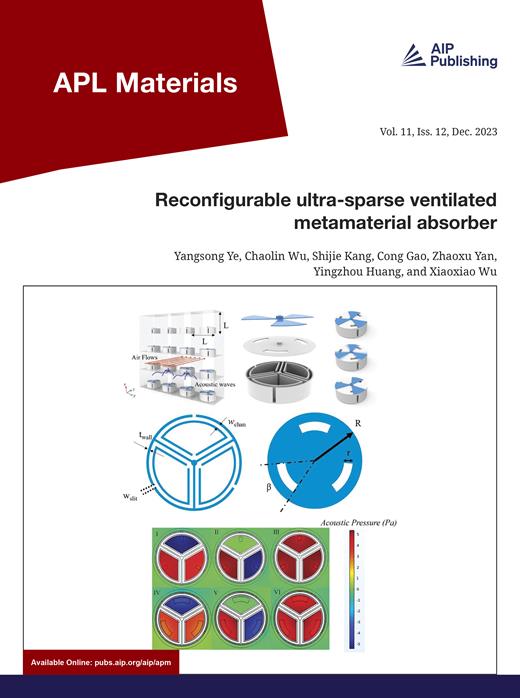掺杂 Pr3+ 的 Sr2Al2GeO7 下转换荧光粉的可见光/近红外发光和浓度效应
IF 5.3
2区 材料科学
Q2 MATERIALS SCIENCE, MULTIDISCIPLINARY
引用次数: 0
摘要
Pr3+ 离子作为红色和近红外(NIR)发光中心已被广泛掺杂到各种材料中,应用于照明和太阳光谱降频。本文通过粉末 X 射线衍射图样和里特维尔德精炼证明了一种新的掺杂 Pr3+ 的 Sr2Al2GeO7 荧光粉库的制备,并用扫描电子显微镜和能量色散 X 射线光谱仪对其进行了表征。Sr2Al2GeO7:Pr3+ 样品强烈吸收 420-500 纳米波长的蓝色光子,并产生强烈的可见光发射,其中 490 纳米波长附近的主峰来自 Pr3+ 3P0 → 3H4跃迁,同时还产生 800-1200 纳米波长的强近红外发射带。除了 880 纳米处的 1D2 → 3F2、1000 纳米处的 1G4 → 3H4、1070 纳米处的 1D2 → 3F3,4 等典型跃迁外,通过静态和动态光谱分析,3P0 → 1G4 跃迁还在 929 纳米处产生了可区分的近红外发射。最有趣的是,对于 3P0 蓝激发态,约 10%Pr3+ 的高浓度是可见光/近红外发射的最佳浓度,这与 1D2 态稀释后的最佳浓度 1%Pr3+形成了鲜明对比。理论推测和实验结果对 Pr3+ 与 3P0 和 1D2 状态之间的相关交叉弛豫进行了全面处理。这种浓缩的 Pr3+ 蓝色激活剂将通过从 3P0 初始状态到 1G4 中间级的理想两步顺序转换,极大地促进从蓝色到近红外的下变频,使量子效率超过 1。目前的研究成果将巩固聚合 Pr3+ 给体的基础,以促进新型 Pr3+/Yb3+ 共价下转换,从而大大提高硅太阳能电池的效率。本文章由计算机程序翻译,如有差异,请以英文原文为准。
Visible/near-infrared luminescence and concentration effects of Pr3+-doped Sr2Al2GeO7 downconversion phosphors
The Pr3+ ion has been widely doped into various materials as a red and near-infrared (NIR) emitting center for applications in lighting and solar spectrum downconversion. Herein, the preparation of a new library of Pr3+-doped Sr2Al2GeO7 phosphors was proved by powder x-ray diffraction patterns and Rietveld refinements and characterized by a scanning electron microscope with energy-dispersive x-ray spectrometry. The Sr2Al2GeO7:Pr3+ sample strongly absorbs blue photons over 420–500 nm and yields intense visible emissions with dominant peaks around 490 nm from the Pr3+ 3P0 → 3H4 transition, as well as robust NIR emission bands over 800–1200 nm. In addition to the typical transitions of 1D2 → 3F2 at 880 nm, 1G4 → 3H4 at 1000 nm, and 1D2 → 3F3,4 at 1070 nm, the distinguishable NIR emission at 929 nm was demonstrated from the 3P0 → 1G4 transition via static and dynamic spectroscopic analysis. Most interestingly, for the 3P0 blue-excited state, a considerably elevated concentration of about 10%Pr3+ was optimal for the visible/NIR emissions, in stark contrast to the diluted optimal 1%Pr3+ for the 1D2 state. The relevant cross-relaxation from the 3P0 and 1D2 states between Pr3+ was comprehensively treated by theoretical speculations and experimental results. Such concentrated Pr3+ blue activators would significantly facilitate the blue-to-NIR downconversion through a desired two-step sequential transition from the 3P0 initial state to the 1G4 intermediate level for quantum efficiency exceeding unity. The current results would consolidate the basis of concentrated Pr3+ donors to promote the novel Pr3+/Yb3+ codoping downconversion for greatly increasing Si solar cell efficiency.
求助全文
通过发布文献求助,成功后即可免费获取论文全文。
去求助
来源期刊

APL Materials
NANOSCIENCE & NANOTECHNOLOGYMATERIALS SCIE-MATERIALS SCIENCE, MULTIDISCIPLINARY
CiteScore
9.60
自引率
3.30%
发文量
199
审稿时长
2 months
期刊介绍:
APL Materials features original, experimental research on significant topical issues within the field of materials science. In order to highlight research at the forefront of materials science, emphasis is given to the quality and timeliness of the work. The journal considers theory or calculation when the work is particularly timely and relevant to applications.
In addition to regular articles, the journal also publishes Special Topics, which report on cutting-edge areas in materials science, such as Perovskite Solar Cells, 2D Materials, and Beyond Lithium Ion Batteries.
 求助内容:
求助内容: 应助结果提醒方式:
应助结果提醒方式:


